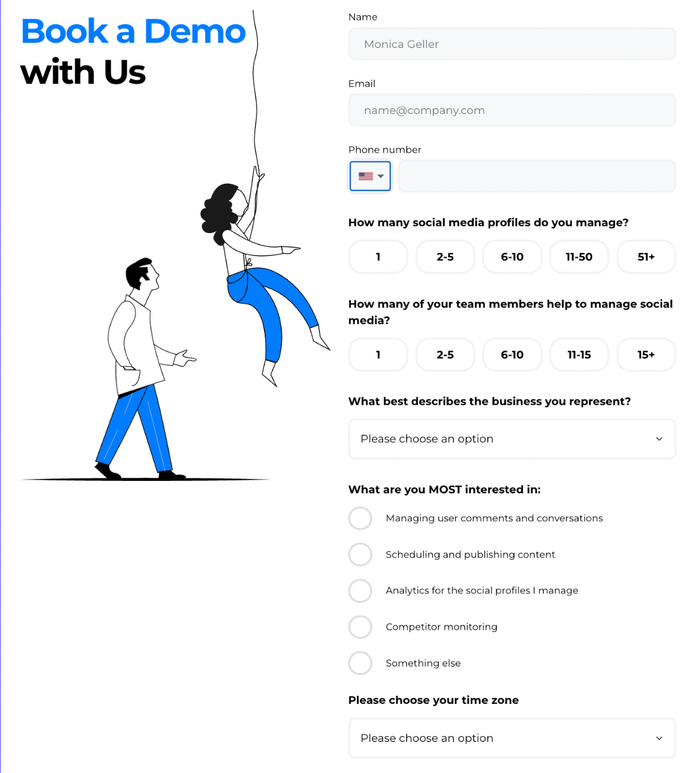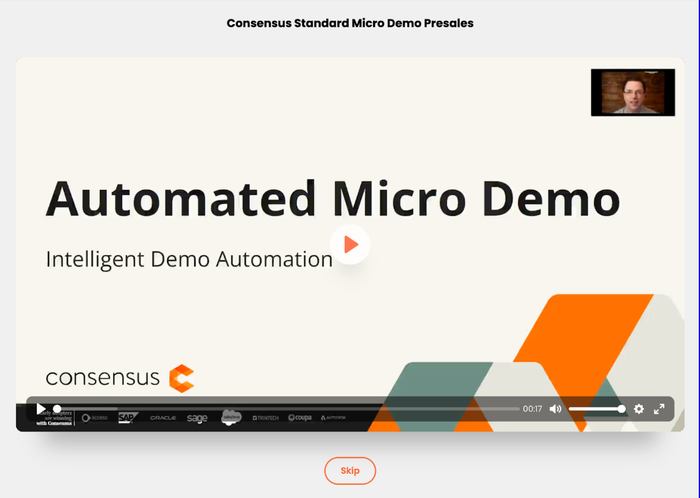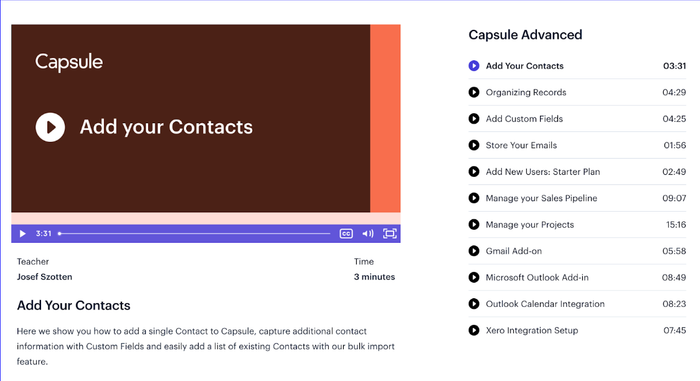Product demos are a powerful tool to showcase your offerings. They bring your product or service to life, demonstrating its purpose and value.
However, the problem with product demos is that many companies don’t see the value in them, and either don’t provide them or don’t execute them with their audience's needs in mind.
Today, we'll show you not only what a product demo is but also what types of product demos are worth implementing – and how to do it.
What is a product demo?
A product demo is a presentation or showcase of a product's features and benefits, and how it can solve common business problems.
Benefits of a product demo
A successful demo video comes with a lot of advantages that other forms of selling might not offer.
1. Showcasing key product features
In a successful demo, the sales team highlights the product's key features in a way that addresses the prospective customer's specific concerns.
With this technique, the demo stays relevant and compelling, and highlights how these features can help solve the customer's problems.
For instance, a SaaS company might use a product demo video to walk through the software's interface.
2. Personalizing the sales experience
A personalized demo, carefully crafted by the sales rep, can make a big difference in the sales process. A sales rep can demonstrate a deep understanding of the prospect's needs with a single demo, by focusing on their challenges.
For example, in a high-performing sales team, reps might prepare multiple demos. Each product demo video would be tailored to different segments of the target market, showing how the product uniquely addresses each segment's pain point.
3. Accelerating the sales cycle for a sales team
Product demos can shorten the sales cycle.
Demonstrations allow potential customers to see the product in action, ask questions and alleviate doubts in real-time. This immediate visual proof can then move the buyer quicker through the decision-making process, from interest to purchase.
Many sales reps find that a good sales demo, especially when followed by a clear call to action, can speed up the closing of deals – particularly in competitive markets.
4. Improving customer understanding and engagement
Effective product demos engage potential customers by making the product's features and benefits clear and relatable.
This helps prospects understand the value proposition in a compelling way and builds a deeper engagement with the product or service.
A live demo allows for real-time engagement, where prospective customers can interact with the product and deepen their interest in the presented solution.
5. Improving lead qualification
A well-executed demo can serve as a tool for qualifying leads, and help you avoid tire kickers. The sales team can save their efforts and only invest time in potential customers who are a good fit for the product.
Product demo videos help sales reps figure out which leads are ready for the next step in the sales funnel – so they can focus their sales efforts on those that are most likely to convert.
6. Building trust and credibility
A good product demo proves your product's value and effectiveness, building confidence with prospective customers. This is especially true for physical products or complex SaaS solutions, where seeing is believing.
Demo videos can serve as social proof, often including successful use cases and testimonials from satisfied customers, which encourages new prospects.
7. Driving action with a clear call to action
The end of a product demo is an ideal time to engage prospective customers and urge them to take action. A compelling call to action is essential for all types of conversions, including signing up for a trial, setting up a follow-up meeting, or signing an annual agreement straight away.
This pushes prospects closer to becoming customers by taking advantage of the momentum and interest generated by the demo.
Types of product demos
Interactive demo
An interactive demo allows a prospective customer to explore the product's capabilities up close and personal.
Unlike traditional product demonstrations, where an account executive leads the presentation, an interactive demo encourages the potential customer to check the product's features on their own terms.
Incorporating an interactive demo into your sales pitch can boost the potential annual contract value by showcasing the product's capabilities in real-time. Potential customers appreciate the opportunity to test the product without the pressure of a live demo, giving them the space to evaluate its fit for their needs.
It’s also a time-saver for your sales team, as it’s an easy way for more people to see what's great about the product without needing a big sales pitch or numerous calls.
This type of demo can be:
- embedded on your website for free access,
- gated behind an email submission,
- available on demand.

Demos don't always have to be videos. A demo just refers to when you give people a sense of how your product works before they sign up.
Quetext, for instance, allows potential users to use their plagiarism checker for free – no strings attached.

Qualifying product demo video
Qualifying demos are short, sharp, and designed to sift through the high volume of early-stage leads. Lasting between 10-20 minutes, these demos help identify if a prospect's problem aligns with the solution offered, turning a prospect into a qualified lead.
Sales teams proceed carefully here, knowing not every demo will result in a closed deal. Prompting people to commit right at the start of their buyer journey is not an easy task. Yet, this step is necessary for focusing efforts on the right audience.
Imagine a scenario where a sales rep demonstrates a software's basic functionalities to gauge a lead's interest and specific needs. The goal is to get into more detail if there's a match, leading to a more in-depth conversation.
While it might seem like you lose time by not proceeding with every prospect, qualifying demos are invaluable in storytelling – helping the sales team invest time in leads with genuine potential.
Dedicated demo
A dedicated demo is about showing a particular company how a product can solve their specific problems. Consider it a customized guide outlining how you can help a potential customer with their particular issue.
When the sales team sets up these demos, their goal is to craft a great demo focused on the company's pain points. This helps a lot in convincing prospects because it's like saying, "We know what's troubling you, and here's how we can fix it." It's an important – and often, the very first – part of the buyer's journey, where the company sees the product as a hero for their issues.
NapoleonCat, for example, offers a dedicated demo upon filling out a form and providing a few details about the company.

Whether it's a physical product or a software solution, giving a general overview of the product helps qualify leads by attracting only those who see the value in what's being offered.
Micro demo (Feature demo)
A micro demo is a quick, efficient way to showcase a product's capabilities, directly addressing a prospect's challenges and pain points within just a few minutes.
During this type of demonstration, the product's key features are highlighted – along with how they impact customer success directly.
A few examples include:
- a software company might use a micro demo to show off a new feature that simplifies data analysis,
- a brief video that demonstrates how to clean up specific laptop files,
- a short product demonstration focused on showing time savings for a particular industry.
Here’s an example from Consensus:

Pre-recorded demo
Pre-recorded demos are videos available for anyone to watch, often found on platforms like YouTube or a company's landing page. They usually show how a product works and what it does – without requiring the viewer to sign-up or share personal details.
Such demos are powerful tools to generate leads, as they can reach a wide audience and spark interest in potential new users.
Viewers who find the demo matches their needs can then pursue a more detailed demo with a sales rep. Pre-recorded demos serve as an initial touchpoint for lead generation, as they give a glimpse into the product's capabilities and provide proof of its effectiveness.
Technical demo
A technical demo is usually done by someone who knows the ins and outs of the product, like a member of the technical sales team or a technical lead. The right demo goes deep into details like integrations, technical setups, and API configurations.
These topics might not be familiar to decision makers themselves, but they need the information from their technical or sales team to decide whether to proceed with a particular solution – or not.
When creating product demos of this nature, the goal is to show the key benefits of how the product works on a technical level. This should help address the buyer's pain points, e.g., for SaaS companies looking to integrate new solutions into their systems.
A good technical demo is done live so that questions can be answered in real time. Providing clear, detailed insights into the product's compatibility with their existing technical environment helps convince prospects.
Vision demo
Vision demos focus on the big picture of a product, highlighting how it addresses pain points and benefits the sector. They talk more about the advantages users gain rather than listing every feature.
The goal is to show the value the product brings to the table, making it less about the sale and more about the impact it can have.
For example, a vision demo for an email outreach tool might not dive into every tool and button. Instead, it would show how this tool makes team collaboration smoother and projects more successful – appealing directly to managers looking for solutions to team disorganization and project delays.
Woodpecker has a series on their YouTube channel about their integrations. They show how these integrations benefit their audience instead of how they work.
The approach is more marketing-oriented, designed to draw in those who are looking for ways to improve their operations.
Trade fair demo
Trade fair demos are 90% about a good story, and 10% about the specifics of the product.
At trade fairs, the product demo is live, direct, and usually generic, meaning it’s designed to catch the interest of many. For example, a company might showcase a new tech gadget with a story of how it can transform everyday tasks into something simpler and more enjoyable.
The goal is to create a connection, leaving the details for a deeper conversation after the fair. Interested prospects can then follow up to learn more, turning that initial interest sparked by a compelling story into a genuine business opportunity.
Screencast demo
A screencast demo captures the computer screen to show how a product or feature operates, while a voice-over provides detailed explanations of the steps being taken.
In this format, the viewers can see exactly how the product functions in a real-world scenario. It's particularly useful for online tutorials or walkthroughs, as companies can demonstrate the use of new features or complex functionalities in a straightforward manner.
For example, Capsule CRM has a series of product demo videos showcasing the software features.

Screencast demos are highly effective for software products, enabling users to learn how to use them at their own pace. With the ability to pause, rewind, and replay the video, users find it easier to grasp new tools or features, making the learning process more intuitive and engaging.
Closing demo
Many think that a demo is something you can only show at the start of a sales process, but a closing demo is also an important part of the sales cycle.
It's your final chance to showcase how your product fits perfectly with the prospect's needs. Unlike initial demos, a closing demo is highly personalized, focusing on the specifics that matter most to the decision-maker.
This is where you reiterate the benefits demonstrated in the product demo, aligning them with the doubts you've had to dispel throughout the sales journey.
A product demo video used in the closing phase of a sales process can reinforce key messages and provide a clear, concise recap of your product's value proposition.
FAQ demo
An FAQ demo is at the heart of the sales process. It answers questions that prospects have after initial meetings but before the final one. The first product demo video is key here, as it should clearly show answers to common questions.
However, if that doesn’t happen, a second product demo video might demonstrate the product's flexibility, and a third video could share success stories, showing the product solving real-world problems.
The aim is to turn prospects into more interested leads. Through a product demo video, companies tackle doubts and build trust. This step moves prospects closer to saying yes, as it addresses their concerns without rushing the decision.
What to include in each product demo? Checklist
- Start with a clear introduction. State what the product is and its main benefit. Make it short and engaging.
- Highlight the key features. Focus on the features that solve problems for your prospective customer. Explain one feature at a time – unless they are connected.
- Show the product in action. Use examples or scenarios where the product solves a specific problem. This makes the demo relatable.
- Include social proof. Share testimonials or success stories from existing users. By doing this, you build trust and credibility.
- Explain the sign-up process. Make it clear and simple. Show any key steps if needed.
- Mention pricing briefly. Give an overview of pricing plans if applicable. Be transparent – but brief.
- End with a call to action. Tell viewers exactly what to do next. Whether it's to sign up, learn more, or contact a sales rep, make it clear.
- Keep it short. Aim for a length that holds attention but covers all points. Shorter product demo videos tend to engage better – for a dedicated demo, though, adjust the length according to your audience's preferences.
- Ensure high video and audio quality. Invest in good production values. Clear visuals and audio make a good demo great.
- Tailor the content for your audience. Customize the video to address the specific needs of your target audience. Knowing your audience helps make the demo more effective.
- Test and refine based on feedback. Use feedback from viewers to improve future product demo videos.
- Focus on the after-sales support. Highlight the support and training options available. This reassures prospective customers about post-purchase assistance.
- Track your leads. Use tools like Capsule CRM to monitor who engages with your demo and how prospective they are for your business. This helps in follow-up and understanding the demo's impact on lead generation.
Common product demo mistakes and how to avoid them
Mistake #1: Overloading with features
Don’t lose your audience in a sea of unnecessary details. A sales demo shouldn’t showcase everything your product does – it should present what matters most to the audience. Tailor your product demonstration to focus on the specific challenges your prospects face and the solutions they need.
For example, if you sell to small businesses, highlight how your tool simplifies day-to-day operations instead of covering enterprise-level analytics features or highlighting the necessity of integrating with embedded analytics tools.
Mistake #2: Ignoring audience-specific concerns
A generic sales presentation usually fails to connect. If you don’t address the unique pain points of your audience, you miss the chance to move them further along the sales funnel.
For example, If you skip over a healthcare client's regulatory concerns during a demo, they may lose interest. Instead, you should show examples of how your solution ensures compliance – giving them confidence in your offering.
Mistake #3: Skipping over objections
Failing to address objections during a demo leaves doubts and questions unanswered. Anticipate common concerns and weave solutions into your sales demos naturally.
For instance, if your product’s pricing is a sticking point, emphasize the long-term value and potential ROI during the demo to ease hesitation.
Over to you
A product demo is just the beginning – it opens doors and sparks interest. Follow-up is key to convert interest into sales. Keep engaging with leads, offer more information and support, and never stop showing your USP.
This journey from product demo to customer is where success lies.
Frequently Asked Questions
A demo product is a version of a product used in a demonstration to showcase its features. Sales demos often use product demo video examples, interactive demos, or video demonstrations to help customers understand the product's value.
To create a product demo, identify key features and benefits. Use video demos, interactive demos, or your own video to showcase the product. You can also use an online learning platform or augmented reality app for engaging product demonstration videos.
A product demo is important because it allows potential customers to see the product in action. Sales demos and product demo examples, such as video demos or interactive demos, help build trust and understanding, often driving purchasing decisions.
Sales teams or product experts typically give product demonstrations. They may use demo center presentations, video demos, or their own video demonstrations to engage potential customers, ensuring the product's key features are clearly communicated.
A good product demo effectively highlights key features in an engaging way. Using short demo videos, interactive demos, and product demo examples ensures that the product demonstration resonates with the audience, whether done in a demo center or online.
In a product demo, avoid overwhelming customers with too much information or technical jargon. Keep it simple and engaging by using product demonstration videos, interactive demos, and a clear focus on the product's value to the customer.
To script a product demo, outline key points to highlight. Use engaging language and incorporate video demos, interactive demos, or product demonstration videos. Ensure the script flows naturally, whether for a live demo center presentation or an online demonstration.
Sales teams or product experts should conduct product demos. They understand the product’s features and can use demo videos, product demo examples, or interactive demos to showcase the product effectively, whether in a demo center or through online platforms.
A product demo should last between 15 to 30 minutes, depending on the complexity. A short demo video or interactive demo should focus on key features, similar to product demo examples, ensuring a concise and impactful product demonstration.
To demo a product, highlight key features using product demonstration videos or interactive demos. Create a product demo through your own video or an online learning platform, ensuring the product demo examples engage and resonate with your audience.




